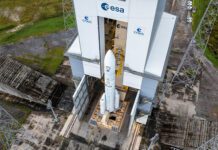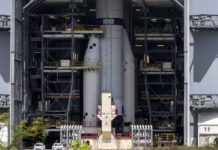
An Ariane 6 Launcher Task Force update has identified exceeded temperature limits as the cause of an APU anomaly during the rocket’s inaugural flight.
Europe’s Ariane 6 rocket was launched for the first time on 9 July 2024 from the Guiana Space Centre. While the initial phase of the flight was completed as expected, an anomaly with the rocket’s Auxiliary Power Unit (APU) during a demonstration phase of the mission resulted in the mission’s final upper stage burn being abandoned. The rocket’s upper stage remains in orbit with two reentry capsules that were scheduled to be deployed after the rocket’s final burn.
Following the flight, an investigation into the anomaly was launched by the Ariane 6 Launcher Task Force, which is made up of ESA, CNES, ArianeGroup, and Arianespace. In a 16 September update, the Task Force announced that the investigation had identified a single temperature measurement that “exceeded a predefined limit” as the root cause of the anomaly. The tripped limit caused the software to trigger a shutdown of the APU which ensured the rocket’s Vinci upper stage engine could not be restarted for the final burn.
In order to remedy this issue and ensure a similar shutdown does not occur in the future, the ignition preparation sequence, specifically the APU chill-down sequence, has been changed. The updated flight software is already being tested as teams prepare for the rocket’s first commercial flight which is set to take place before the end of the year.
While the update brings much-needed closure to the rocket’s inaugural flight campaign, an interesting admission appears to have been made. According to the update, the investigation that identified the root cause of the APU shutdown was concluded in August. As a result, the Task Force has been sitting on the results of that investigation for well over two weeks. This may be because the Task Force was waiting for teams to implement a fix before publishing the update. However, it does call into question ESA’s stated commitment to transparency.




